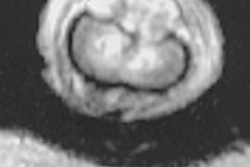A partially parallel MR image acquisition technique known as SMASH is a hit with researchers from Beth Deaconess Medical Center in Boston. In the October issue of Radiology, they describe consistent spatial and temporal improvements obtained with the technique compared to 3-D contrast-enhanced MR angiography (MRA).
While MRA can be a safe and useful adjunct to conventional x-ray angiography, poor spatial resolution in most applications has kept it from competing successfully with conventional x-ray angiography. MRA has other limitations as well, including the need for short image acquisition times to facilitate breath-holding and maximize image enhancement with gadolinium contrast. MRA's speed and resolution are also limited by gradient hardware specifications, and the need to avoid neuromuscular stimulation as a result of too-rapid gradient switching.
These limitations led to the development of a pilot study by Dr. Daniel Sodickson and colleagues from Beth Israel Deaconess Medical Center in Boston (Radiology, October 2000, Vol. 217:1, pp.284-289). In it, simultaneous acquisition of spatial harmonics (SMASH) techniques were used to halve the breath-hold duration while maintaining consistent spatial resolution -- or alternately, to double the spatial resolution at a fixed breath-hold duration. As expected, there was some loss of signal-to-noise ratio in the SMASH images.
Imaging protocol
Eight healthy adults, ages 20-42, participated in the study. Five were examined for the reduced breath-hold series, and three for the increased spatial-resolution series. The subjects were placed in the supine position over the posteriorly positioned coil array. Following acquisition of scout images, breath-hold nonenhanced images were obtained with a 3-D MRA sequence to provide in vivo coil sensitivity references.
A 2-ml test bolus of gadopentetate dimeglumine (Magnevist, Berlex Imaging, Wayne, NJ) was obtained, and bolus arrival in the abdominal aorta was determined from signal intensity measurements obtained during T-1-weighted image acquisition. The test bolus was followed by two injections of contrast material about 15 minutes apart -- one for conventional MRA and one for SMASH imaging in random order -- followed by a saline flush.
All contrast-enhanced studies used a 3-D T-1 weighted radiofrequency-spoiled gradient-echo imaging sequence with a 7.0/1.5, 30º flip angle, and 350 x 350-mm field of view. Images were obtained in an oblique-coronal plane, with right-to-left in-phase encoding coinciding with the principal direction of the coil array, the authors wrote. The start of imaging was timed with k space ordering, so that the center of the k space coincided with the peak of the contrast bolus.
Reduced breath-hold SMASH images were obtained in five subjects using a phase-encoding direction reduced by a factor of two -- i.e., twice the k space interval as in the reference images, and a total of 64 phase encoding steps -- with 12-second breath-holds.
Increased breath-hold SMASH images obtained in 3 subjects reduced the field of view by half, while the number of encoding steps remained at 128 -- resulting in a doubled intrinsic spatial resolution and 24-second breath-holds, the authors wrote.
Two larger subjects were chosen for a third contrast injection at 3 mL/sec, double the previous rate, to achieve higher concentration of the contrast material during the reduced-breath-hold SMASH image acquisition.
Finally, one additional subject underwent a single contrast injection without a prior test bolus in order to test the feasibility of time-resolved SMASH MRA.
"The injection rate in this test case was 1.5 mL/sec, but the SMASH acceleration factor was increased to three and multiple time-resolved 8-second 3-D acquisitions were performed during a single breath-hold," the authors wrote.
A traditional sum-of-squares combination of component coil images was used to reconstruct component coil images, but the SMASH data sets required a different technique.
"A similar sum-of-squares reconstruction of the reduced-field-of-view SMASH data sets would yield aliased images, in which all structures seen on the outer half of the corresponding reference images were wrapped back into the remaining narrower field of view. Instead, the reduced-field-of-view raw data sets were reconstructed to full field of view by using linear combinations of component coil signals to substitute for the missing phase-encoding gradient steps," they wrote.
The researchers also used a spatial harmonic fitting approach to make the reconstructions relatively insensitive to variations in tissue characteristics across the in vivo sensitivity references.
Spatial variations in noise background are expected according to SMASH theory, so the researchers checked noise regions against predicted levels to rule out possible bias resulting from spatial separation of arterial regions of interest from the noise estimation regions. SNR and contrast-to-noise measurements were performed on individual magnitude images prior to maximum intensity projection, the authors wrote.
1, 2
Copyright © 2000 AuntMinnie.com


.fFmgij6Hin.png?auto=compress%2Cformat&fit=crop&h=100&q=70&w=100)





.fFmgij6Hin.png?auto=compress%2Cformat&fit=crop&h=167&q=70&w=250)











